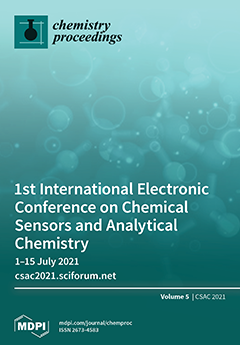Chemical Oxygen Demand (COD) is a widely used parameter in analyzing and controlling the degree of pollution in water. COD is defined as the amount of molecular oxygen (in milligrams of O
2) required to decompose all the organic compounds in 1 L of aqueous solution to carbon dioxide and water. There are many methods reported for COD determination, such as the conventional dichromate titration method. Electro-oxidizing the organic contaminants to completely transform them into CO
2 and H
2O using sensors is considered the best method for COD estimation. Increasing attention has been paid to electrochemical methods because they are highly sensitive, time-saving, low-cost, and easy to operate. In this sense, copper electrodes have been reported based on the fact that copper in alkaline media acts as a powerful electrocatalyst for the oxidation of aminoacids and carbohydrates, which are believed to be the major culprits for organic pollution. Cyclic voltammetry was the technique used to obtain the voltammetric responses. It is common for different organic compounds to show different cyclic voltammogram shapes and current intensities in different concentrations. In this work, four kinds of electrodes modified with copper (Cu)/copper oxide (CuO)/nickel copper alloy (Ni Cu alloy) nanoparticles were studied for COD analysis; this was done by employing the cyclic voltammetry technique, which involved a Nafion film-covered electrodeposited CuO/Cu nanoparticle electrode (
E1), a Cu nanoparticle–graphite composite electrode (
E2), a CuO nanoparticle–graphite composite electrode (
E3), and a Ni Cu alloy nanoparticle–graphite composite electrode (
E4). The COD values were determined via the plotted calibration of COD values vs. the current intensity. Glucose, glycine, potassium hydrogen phthalate (KHP), and ethylene glycol—which show different reducibilities—were chosen as the standard substances to play the role of organic contaminants with different degradation difficulties. From the obtained cyclic voltammograms, we can see that glucose is very easily oxidized by those four electrodes, with electrode
E1 displaying the best performance, with a linear range of 19.2~1120.8 mg/L and limit of detection of 27.5 mg/L (calculated based on the formula 3σ/k). In contrast, it is very difficult for the compound KHP to be oxidized by these four electrodes. Nevertheless, the obtained voltammetric profiles presented different shapes with the tested organic compounds, suggesting these four electrodes can compose an electronic tongue array for multivariate analysis. As a result, the main component of river samples—whose degradation could be easy or difficult—can be evaluated via the PCA technique. This evaluation is very helpful for the accuracy of COD detection. The resulting sensor-based method demonstrates great potential not only for estimating the precise value of COD, but for predicting the difficulty of its degradation; this represents a simple, fast, and clean methodology, which is perfectly suited to the present demands of green techniques.
Full article



